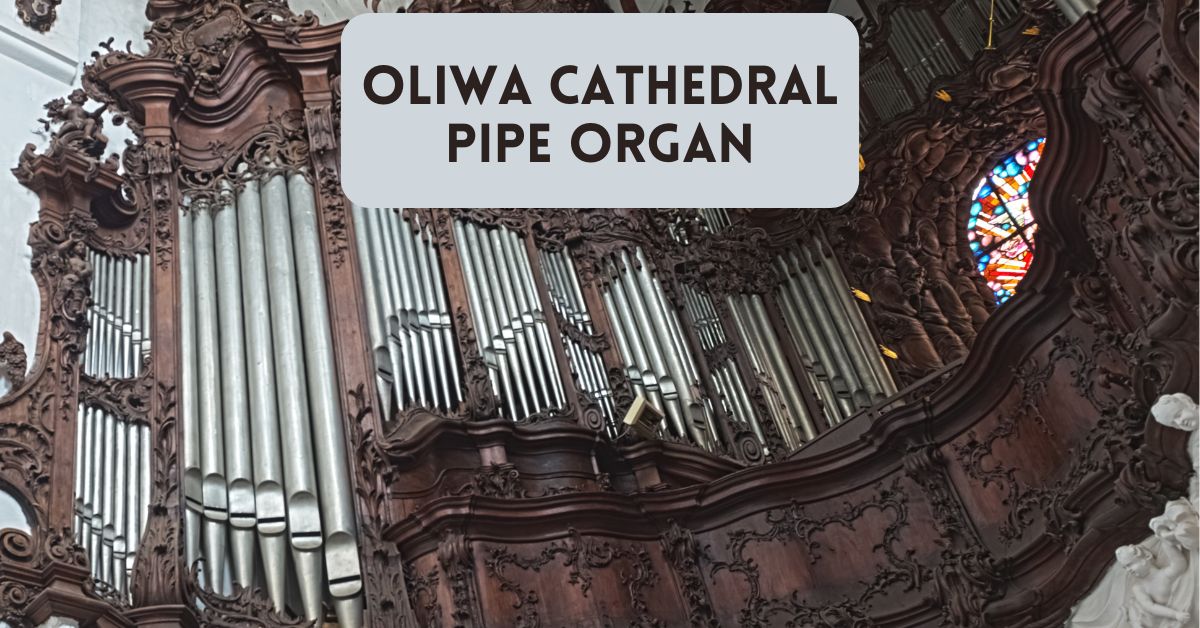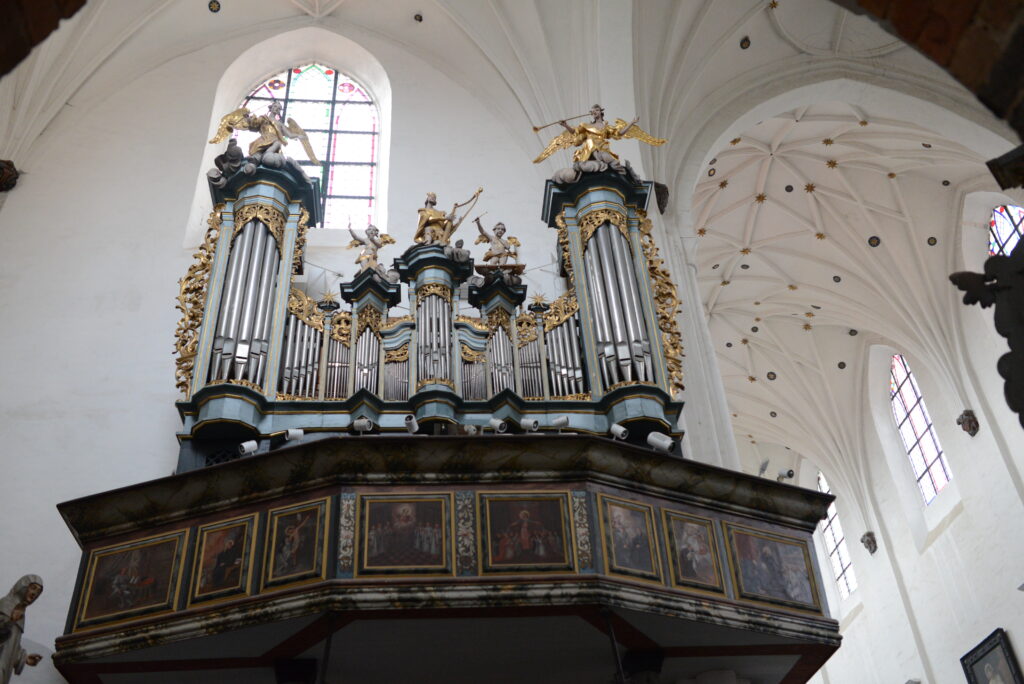Nestled in the serene Oliwa district of Gdańsk, Poland, Oliwa Cathedral is a stunning architectural masterpiece with a rich history stretching over 800 years. The cathedral is renowned for its awe-inspiring Baroque and Rococo interiors and its extraordinary organ. This musical marvel continues to captivate audiences from around the world. In this blog post, we look at the magnificent Oliwa Cathedral organ.
Azure Hills Music contains affiliate links and is a member of the Amazon Services LLC Associates Program. As an Amazon Associate, we earn from qualifying purchases at no extra cost to you when you purchase using one of these Amazon links. Read our disclaimer and privacy policy for more information.
A Brief History of Oliwa Cathedral
The Oliwa Cathedral, officially known as the Archcathedral Basilica of the Holy Trinity, Blessed Virgin Mary, and St. Bernard, was founded in the 12th century by Cistercian monks. Over the centuries, the cathedral has undergone numerous expansions and reconstructions, resulting in a harmonious blend of Romanesque, Gothic, and Baroque architectural styles. The current structure, with its twin spires and elaborate façade, dates back to the 13th century, making it one of Poland’s oldest and most historically significant churches.
During its long history, the cathedral has witnessed significant events, including royal visits and religious ceremonies of great importance. Despite suffering damage during various wars, including World War II, Oliwa Cathedral has been meticulously restored, preserving its historical and cultural legacy for future generations.
The Historic Oliwa Cathedral Organ
The organ at Oliwa Cathedral is a true masterpiece of craftsmanship and artistry. Originally constructed between 1763 and 1788 by Johann Wilhelm Wulff (Brother Michael, a Cistercian Monk), a prominent organ builder of the time, the organ has become one of the most famous in Europe.
The instrument contained 83 registers (5100 pipes) and three manuals. Initially, the console was independently located in the central part of the matroneum, which was unusual in Northern Europe at that time. The organ front was decorated with Rococo sculptures and moveable angels holding bells, trumpets, stars, and suns. Seeing this movement was a unique sight. In the late 1700s, it was the largest organ in Europe and probably the whole world.
The console was moved from the middle to the north wing of the matroneum between 1790-1793.
What sets this organ apart is its impressive size—with over 7,800 pipes and 110 stops—and its ability to produce a remarkable range of sounds, from the softest whispers to thunderous roars.
The organ’s design is a stunning example of the Rococo style, with elaborate carvings and gilded decorations adorning its case. The pipes are arranged in a visually striking manner, creating an almost ethereal effect that enhances the cathedral’s acoustics. The organ also features a unique combination of sound effects, including bird calls, which were innovative for their time and continue to amaze listeners today.
Renovations of the Oliwa Cathedral Organ
Throughout its history, the Oliwa Cathedral organ has undergone several renovations to maintain its grandeur.
The most significant changes in the instrument’s structure were made during the interwar period. Between 1934 and 1935, Gdańsk organ builder Joseph Goebel extended the organ to 4 manuals and added a new electro-pneumatic tracker action with windchests. He used 51 registers from those already existing, renewing some of them and adding some new ones. Moreover, he connected the choir organ to the main console. After completing the work, the Oliwa organ had 82 standard registers and five transmitted ones.
After World War II, in 1955, the organ was thoroughly renovated by Wacław Biernacki from Cracow. The last overhaul of the instrument was done in 1966–1968 by the company of Zygmund Kamiński, from Warsaw. He introduced a new disposition, added several missing pipes, and a newly built positive.
The 20th-century restoration allows the organ to meet contemporary musical standards while preserving its historical integrity. Today, it remains one of Poland’s most important cultural treasures, drawing organists and music enthusiasts from around the world.
Today, the great Oliwa organ comprises 96 registers, five manuals, a pedal, an electro-pneumatic tracker action, and an electronic system recording up to 64 combinations (so-called Setzer type). All the present front pipes are still those made by Johann Wilhelm Wulff. The great organ is connected with the choir organ and is one of the biggest ones in Poland.
Organ Concerts at Oliwa Cathedral
The Oliwa Cathedral is not just a place of worship but also a premier venue for organ concerts. These Oliwa Cathedral organ concerts are held regularly throughout the year and showcase the incredible versatility and power of the cathedral’s instrument. Renowned organists from across the globe perform here, offering audiences the chance to experience classical and contemporary organ music in an unforgettable setting.
The cathedral’s acoustics, combined with the organ’s unique tonal qualities, create a truly immersive experience for concertgoers. Whether you are a seasoned classical music fan or a casual listener, attending an organ concert at Oliwa Cathedral is an experience that should not be missed.
How to Get to Oliwa Cathedral
Oliwa Cathedral is located in the Oliwa district of Gdańsk, which is easily accessible by various means of transportation. If you’re traveling from the city center, the most convenient way to reach the cathedral is by taking the SKM (Fast Urban Railway) to the Gdańsk Oliwa station. From there, it’s just a short walk through the picturesque Oliwa Park to the cathedral.
Alternatively, you can reach the cathedral by car or taxi. Parking is available nearby, although it may be limited during peak tourist seasons. Public buses and trams also serve the Oliwa district, making it accessible from various parts of the city.
For those who enjoy walking, the Oliwa district offers a tranquil escape from the hustle and bustle of central Gdańsk, with its leafy streets and historic buildings. A stroll through Oliwa Park, followed by a visit to the cathedral, is a perfect way to spend a peaceful afternoon.
My Visit to Oliwa Cathedral
I journeyed to Oliwa Cathedral while staying in Gdansk via a short train ride. Walking up to the Cathedral was pleasant as my walk took me through a serene park-like setting: very green with trees, shade, streams, flowers, and ducks. During my Sunday visit, there were vendors outside the church selling Polish food – mushrooms, smoked meats and sausages, and nalewkas (fruit based alcoholic concoctions).
Impressions of Oliwa Cathedral
Inside the church, it appears the walls were painted white at one point, covering original frescos – apparently something that happened in the area at the time of the Protestant Reformation. There are many old paintings and side altars throughout the church. Midway in the church, above the main area, a smaller modest organ is visible. In the back of the church, a stunning large organ, one of the biggest I’ve seen.
Sunday Afternoon Recital at Oliwa Cathedral
We stayed for a short Organ recital that was offered at 4 pm along with many tourists. During the time of the recital, the cathedral shuts the entrance so that the recital is not disturbed. The recital began with an organ transcription of Handel’s Hallelujah Chorus, followed by Schubert’s Ave Maria. There were a few more alternating pieces between allegros and andantes. Then we got to an atonal modern piece that showcased various organ effects, including a pitch bend effect. The final selection that let us hear the lungs of this organ was Bach’s Toccata and Fugue in D minor.
Conclusion
The Oliwa Cathedral organ is more than just a musical instrument; it is a symbol of Poland’s rich cultural heritage and a testament to the enduring power of music. Whether you are drawn by the cathedral’s history, the organ’s beauty, or the allure of an unforgettable concert experience, Oliwa Cathedral is a must-visit destination for anyone traveling to Gdańsk.
Listen To The Oliwa Cathedral Organ
Learn More About Visiting Gdansk
Check out The Places Where We Go podcast episode on Places To Visit Near Gdansk




